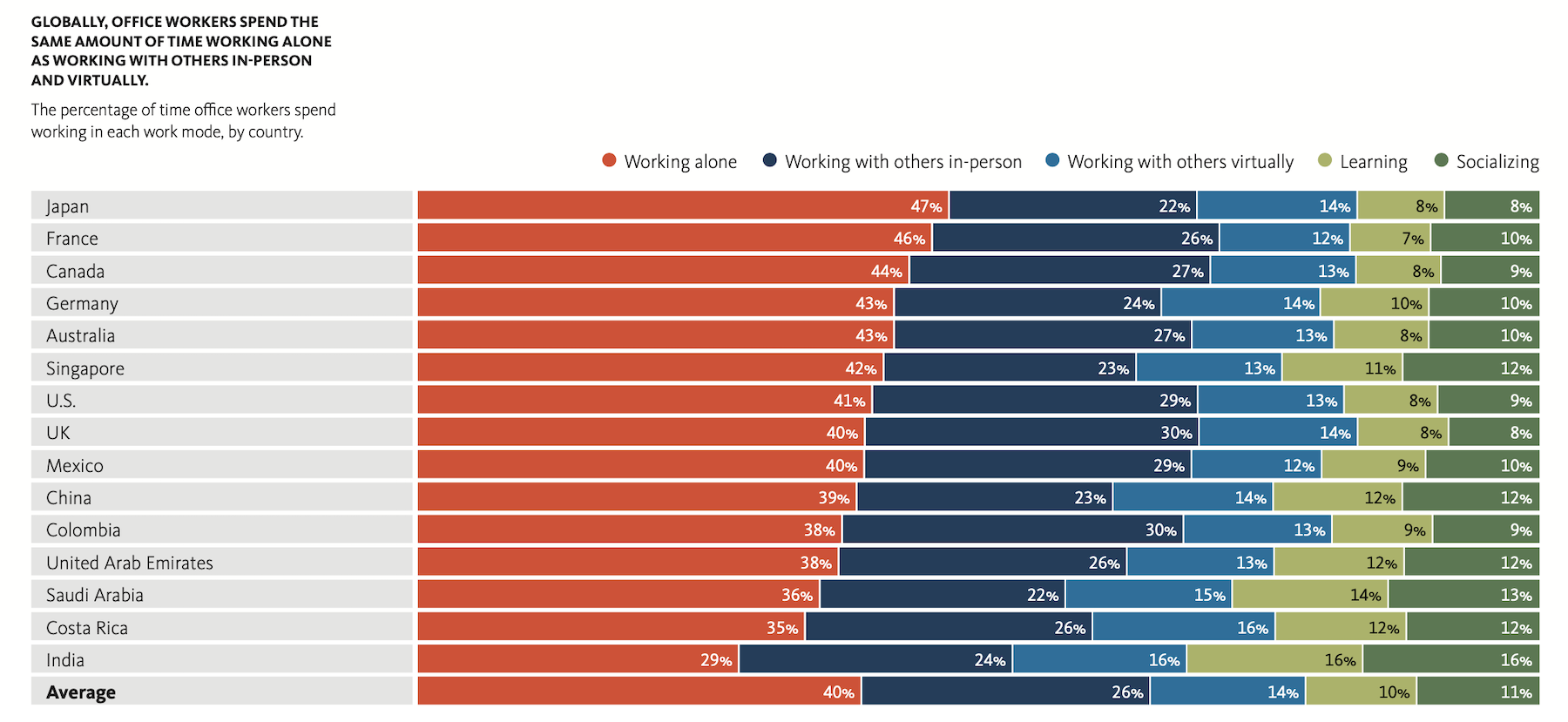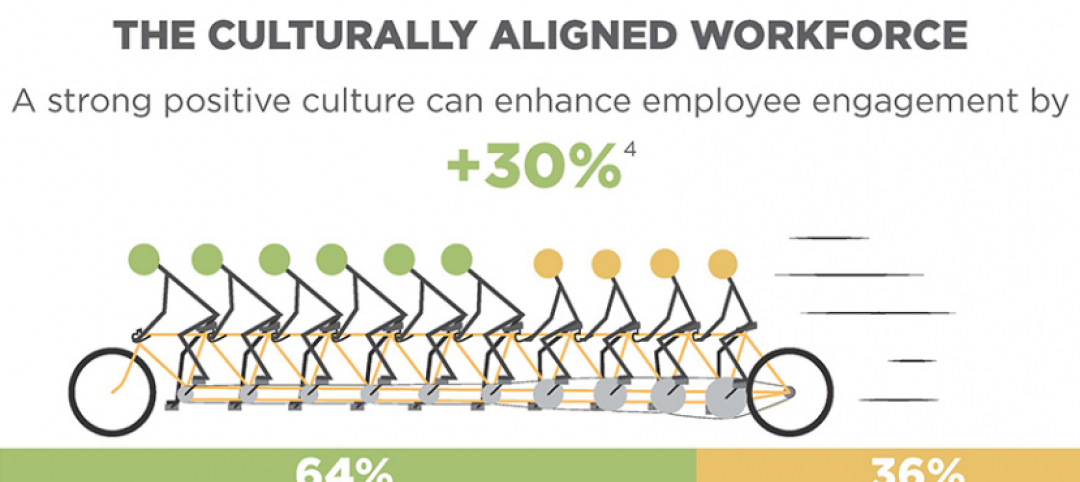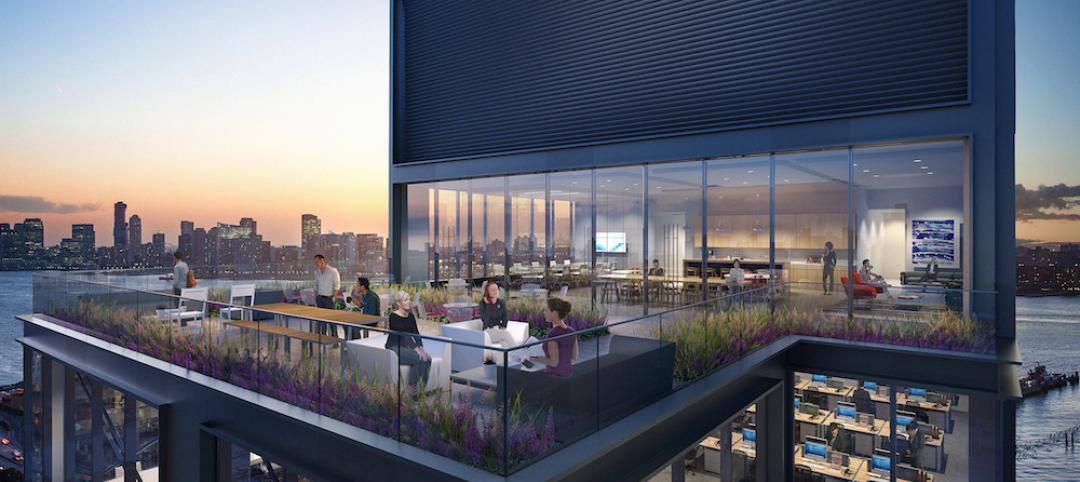For years, AEC firms and their developer clients have worked under the assumption that a good workplace is effective when it fosters working alone, with others in-person and virtually, learning, and socializing.
These factors are foundational as workplace performance indicators. “But having a good workplace is no longer enough,” states The Gensler Research Institute in its Global Workplace Report 2024, which is based on over 16,000 employee responses to a survey conducted in 15 countries and with 10 client industries. (The survey, conducted from October 2023 to January 2024, did not include fulltime remote workers.)
The report contends that employees are seeking different experiences that go beyond functional and effective office spaces, and now include feeling that the space is beautiful, welcoming, and inspires thinking. Within the office, spaces with the greatest impact on performance are innovation hubs, cafés, outdoor areas, and “focus” rooms. Beyond the building itself, exceptional workplaces leverage their surrounding neighborhoods’ amenities and services.
Gensler’s research shows, however, that many workplaces across industries and countries lag in the quality of their workplace experiences.

High-performing employees have more workplace choices
Gensler’s latest study highlights the shift, in gauging an office’s effectiveness, from real estate occupancy to people-centric performance measures, to assess the design impact on how employees work and feel in the workplace, individually, in teams, and as part of a company.

The report defines workplace performance as an average of two composite scores that measure how space supports work and how employees feel about that space. Effectiveness measures factors such as function, layout, and so forth; experience measures factors such as beauty and inspirational feelings.
Global office workers spend half of their typical workweeks in the workplace, 20% of their time at home, and 29% in other locations that might include coworking space. Pre-pandemic, this average was closer to 70% of time in the office. “Now, more than ever, the workplace needs to respond to a wider offering of spaces and experiences,” states the report, adding that employees across the world have unique and individual needs within the office.
The report looks closer at how top performing employees are experiencing their workplaces. The report scores the most-engaged individuals on factors such as how energized and happy they feel while working. Employees with the highest engagement score differ from other workers in the amount of time they spend working alone, learning, and socializing. (The report finds that these employees spend just 36% of their time working alone, versus 44% among the least-engaged employees.)

Nearly all top performers—96%––also say they have control over how they manage their time, versus half of those working in low-performing offices. Gensler emphasizes that “exceptional” workplaces offer their employees choices about where they work within the office. High-performing workplaces offer greater access to spaces for critical work activities, and overall have more work settings to choose from. This empowers the employees to work at the most effective spaces for their tasks.
It's not all about work, either. More than 90% of employees in high-performing workplaces says the office allows them to occasionally unplug from technology. And these workers also tend to use the office more for socializing and having fun.
Amenities add to workplace’s cache
Two-thirds of the workers surveyed describe their company’s office building as “one of the premium, higher-quality” commercial buildings in their areas. Gensler contends that building quality has a direct relationship to workplace quality: high-performing workplaces are twice as likely to be inside high-quality office buildings. These buildings, as often as not, are located in neighborhoods that offer diverse amenities, services, and alternate workspaces. High-performing workplaces, estimates Gensler, have access to 2.6-times as many amenity spaces on-site and 1.6-times as many amenities and services in the neighborhood. “Access to amenities and services appears to make a particular difference,” Gensler states about such “ecosystems” of spaces and experiences.

However, the report also finds that less than one-third of workplaces globally has been redesigned in the last three year, making these workplaces less likely to be able to meet the expectations of young people entering the workforce. “There’s a pressing need for organizations to intentionally rethink office spaces to boost company culture and drive business growth,” says Gensler.
Janet Pogue McLaurin, Gensler’s Global Director of Workplace Research, observes that a great workplace “must not only be a tool to get work done effectively but be intentionally designed for human emotion,” creating experiences that support new ways to work in and outside of the office.
Related Stories
| Aug 12, 2016
Top 70 Office Engineering Firms
Jacobs, AECOM, and Thornton Tomasetti top Building Design+Construction’s annual ranking of the nation’s largest office sector engineering and E/A firms, as reported in the 2016 Giants 300 Report.
| Aug 12, 2016
Top 100 Office Construction Firms
Turner Construction Co., Structure Tone, and Gilbane Building Co. top Building Design+Construction’s annual ranking of the nation’s largest office sector construction and construction management firms, as reported in the 2016 Giants 300 Report.
| Aug 12, 2016
Top 100 Office Architecture Firms
Gensler, HOK, and Perkins+Will top Building Design+Construction’s annual ranking of the nation’s largest office sector architecture and A/E firms, as reported in the 2016 Giants 300 Report.
Office Buildings | Jul 29, 2016
The ROI of company culture: Why companies should look at culture’s impact on profit
Organizations that purposefully craft and develop their culture experience a 14% turnover rate, whereas organizations that ignore their culture experience a 48% turnover rate, writes PDR Senior Consultant Christine Mikhail.
Office Buildings | Jul 13, 2016
Latest Gensler survey links innovation with workplace flexibility
A poll of 4,000-plus U.S. workers finds the most innovative among them spend less time at the office.
Office Buildings | Jul 12, 2016
CF Møller designs LEGO world headquarters complex in Denmark
The 52,000-sm complex will incorporate many familiar motifs from the popular plastic building block toys.
Office Buildings | Jul 11, 2016
CetraRuddy designs office tower for Manhattan’s Meatpacking district
Plans originally called for a hotel, but the architect and developers adapted their design for commercial use.
Market Data | Jul 6, 2016
A thriving economy and influx of businesses spur construction in downtown Seattle
Development investment is twice what it was five years ago.
Contractors | Jul 4, 2016
A new report links infrastructure investment to commercial real estate expansion
Competitiveness and economic development are at stake for cities, says Transwestern.
High-rise Construction | Jun 29, 2016
Best Tall Buildings around the world favor unusual shapes and hybrid functions
The Council on Tall Buildings and Urban Habitat selects winners in four regions.
















